小学英语期末考试知识点大全
2023最新人教版小学一到六年级英语期末复习知识点总结
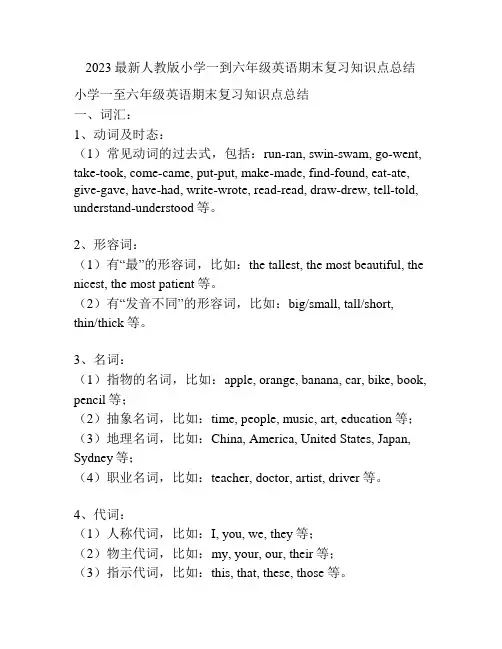
2023最新人教版小学一到六年级英语期末复习知识点总结小学一至六年级英语期末复习知识点总结一、词汇:1、动词及时态:(1)常见动词的过去式,包括:run-ran, swin-swam, go-went, take-took, come-came, put-put, make-made, find-found, eat-ate, give-gave, have-had, write-wrote, read-read, draw-drew, tell-told, understand-understood等。
2、形容词:(1)有“最”的形容词,比如:the tallest, the most beautiful, the nicest, the most patient等。
(2)有“发音不同”的形容词,比如:big/small, tall/short,thin/thick等。
3、名词:(1)指物的名词,比如:apple, orange, banana, car, bike, book, pencil等;(2)抽象名词,比如:time, people, music, art, education等;(3)地理名词,比如:China, America, United States, Japan, Sydney等;(4)职业名词,比如:teacher, doctor, artist, driver等。
4、代词:(1)人称代词,比如:I, you, we, they等;(2)物主代词,比如:my, your, our, their等;(3)指示代词,比如:this, that, these, those等。
5、冠词:(1)不定冠词a/an;(2)定冠词the,在某些情况下可以省略,如:At weekend.6、介词:(1)时间介词,比如:in, on, at;(2)地点介词,比如:to, from;(3)方式介词,比如:by, with;(4)其他介词,比如:of, for, like, under, behind等。
小学英语期末知识总结
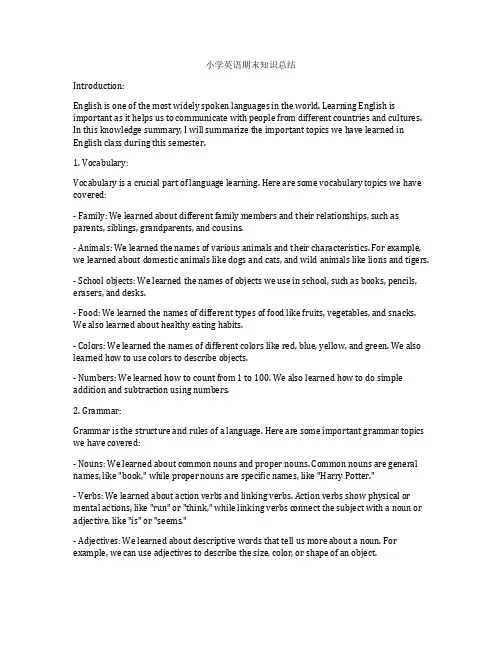
小学英语期末知识总结Introduction:English is one of the most widely spoken languages in the world. Learning English is important as it helps us to communicate with people from different countries and cultures. In this knowledge summary, I will summarize the important topics we have learned in English class during this semester.1. Vocabulary:Vocabulary is a crucial part of language learning. Here are some vocabulary topics we have covered:- Family: We learned about different family members and their relationships, such as parents, siblings, grandparents, and cousins.- Animals: We learned the names of various animals and their characteristics. For example, we learned about domestic animals like dogs and cats, and wild animals like lions and tigers.- School objects: We learned the names of objects we use in school, such as books, pencils, erasers, and desks.- Food: We learned the names of different types of food like fruits, vegetables, and snacks. We also learned about healthy eating habits.- Colors: We learned the names of different colors like red, blue, yellow, and green. We also learned how to use colors to describe objects.- Numbers: We learned how to count from 1 to 100. We also learned how to do simple addition and subtraction using numbers.2. Grammar:Grammar is the structure and rules of a language. Here are some important grammar topics we have covered:- Nouns: We learned about common nouns and proper nouns. Common nouns are general names, like "book," while proper nouns are specific names, like "Harry Potter."- Verbs: We learned about action verbs and linking verbs. Action verbs show physical or mental actions, like "run" or "think," while linking verbs connect the subject with a noun or adjective, like "is" or "seems."- Adjectives: We learned about descriptive words that tell us more about a noun. For example, we can use adjectives to describe the size, color, or shape of an object.- Adverbs: We learned about words that describe verbs, adjectives, or other adverbs. Adverbs often end in "ly" and tell us more about the action, like how, when, or where something happened.- Sentence structure: We learned about the basic structure of a sentence, which includes a subject and a predicate. The subject is who or what the sentence is about, while the predicate tells us what the subject is doing or being.3. Reading and Comprehension:Reading is an essential skill in learning a language. Here are some reading strategies and comprehension skills we have learned:- Phonics: We learned how to blend different sounds to make words. By understanding phonics, we can sound out and read unfamiliar words.- Sight words: We learned common words that cannot easily be sounded out, like "the," "said," or "have". Memorizing sight words helps us read more fluently.- Reading strategies: We learned different strategies to understand a text, such as predicting what will happen, making connections to our own experiences, and asking questions while reading.- Summarizing: We learned how to summarize what we have read by identifying the main idea and important details. Summarizing helps us understand and remember the information better.4. Writing:Writing is another important aspect of learning English. Here are some writing skills we have practiced:- Sentence writing: We practiced writing complete sentences by making sure each sentence has a subject and a predicate. We also learned about capitalization and punctuation rules.- Paragraph writing: We learned how to write a paragraph with a topic sentence, supporting details, and a concluding sentence. Writing paragraphs helps us organize our ideas and present information more coherently.- Creative writing: We had opportunities to write creatively, such as writing stories or poems. Creative writing allows us to express our thoughts and ideas in a creative and imaginative way.Conclusion:In this knowledge summary, we have covered important topics in vocabulary, grammar, reading, comprehension, and writing in our English class. By reviewing these topics, I am confident that I have improved my English skills and am ready to move on to the next level.English is a lifelong journey, and I am excited to continue learning and exploring the language.。
六年级期末英语知识点
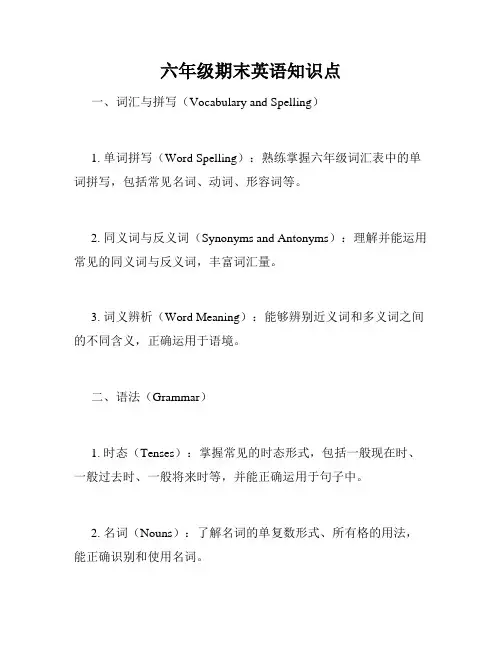
六年级期末英语知识点一、词汇与拼写(Vocabulary and Spelling)1. 单词拼写(Word Spelling):熟练掌握六年级词汇表中的单词拼写,包括常见名词、动词、形容词等。
2. 同义词与反义词(Synonyms and Antonyms):理解并能运用常见的同义词与反义词,丰富词汇量。
3. 词义辨析(Word Meaning):能够辨别近义词和多义词之间的不同含义,正确运用于语境。
二、语法(Grammar)1. 时态(Tenses):掌握常见的时态形式,包括一般现在时、一般过去时、一般将来时等,并能正确运用于句子中。
2. 名词(Nouns):了解名词的单复数形式、所有格的用法,能正确识别和使用名词。
3. 代词(Pronouns):掌握主要的代词形式,包括人称代词、物主代词、反身代词等,并能正确运用于句子中。
4. 形容词与副词(Adjectives and Adverbs):熟悉常见的形容词和副词的用法,能正确描述人物和事物。
5. 介词(Prepositions):理解并能正确使用常见的介词,如in、on、at等,使句子语法更加准确。
6. 连词(Conjunctions):了解并能正确运用并列连词和从属连词,使句子逻辑连贯。
三、阅读理解(Reading Comprehension)1. 主旨理解(Main Idea):能够抓住文章的中心主题,理解作者的观点和意图。
2. 细节理解(Detail Understanding):能够从文章中获取具体细节信息,包括人物、时间、地点等。
3. 推理判断(Inference):能够根据文章中的线索进行推理和判断,理解隐含的意义。
4. 语境猜测(Context Clues):能够根据上下文的内容猜测生词的意思,提高阅读理解能力。
四、写作(Writing)1. 句子结构(Sentence Structure):能够使用简单句、复合句和并列句等不同的句子结构,使文章表达更加丰富。
小学四年级英语考试知识点汇总
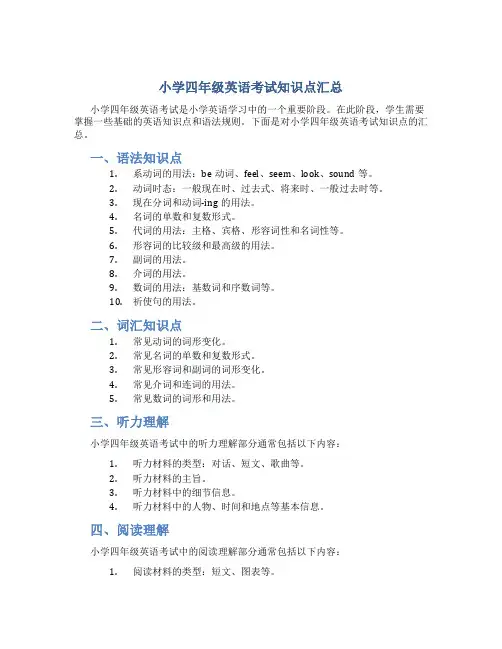
小学四年级英语考试知识点汇总小学四年级英语考试是小学英语学习中的一个重要阶段。
在此阶段,学生需要掌握一些基础的英语知识点和语法规则。
下面是对小学四年级英语考试知识点的汇总。
一、语法知识点1.系动词的用法:be动词、feel、seem、look、sound等。
2.动词时态:一般现在时、过去式、将来时、一般过去时等。
3.现在分词和动词-ing的用法。
4.名词的单数和复数形式。
5.代词的用法:主格、宾格、形容词性和名词性等。
6.形容词的比较级和最高级的用法。
7.副词的用法。
8.介词的用法。
9.数词的用法:基数词和序数词等。
10.祈使句的用法。
二、词汇知识点1.常见动词的词形变化。
2.常见名词的单数和复数形式。
3.常见形容词和副词的词形变化。
4.常见介词和连词的用法。
5.常见数词的词形和用法。
三、听力理解小学四年级英语考试中的听力理解部分通常包括以下内容:1.听力材料的类型:对话、短文、歌曲等。
2.听力材料的主旨。
3.听力材料中的细节信息。
4.听力材料中的人物、时间和地点等基本信息。
四、阅读理解小学四年级英语考试中的阅读理解部分通常包括以下内容:1.阅读材料的类型:短文、图表等。
2.阅读材料的主旨。
3.阅读材料中的细节信息。
4.阅读材料中的生词和短语的理解。
五、写作表达小学四年级英语考试中的写作表达部分通常包括以下内容:1.句型的正确性。
2.词汇的正确使用。
3.文章的段落结构和连贯性。
4.语法和拼写的正确性。
六、口语表达小学四年级英语考试中的口语表达部分通常包括以下内容:1.熟练掌握基础的口语表达能力。
2.表述清晰,语音准确。
3.能准确使用所学的语法和词汇。
七、考试技巧小学四年级英语考试中,除了掌握以上基础知识点外,还需要具备一定的考试技巧,以保证考试的高分。
1.提前准备:提前熟悉考试内容和考试形式。
2.注意时限:合理利用考试时间。
3.精读题目:仔细阅读题目,理解题目要求。
4.注意答题顺序:先完成易答、短答题目,再解答难题。
小学英语必考知识点总结_小学英语总结
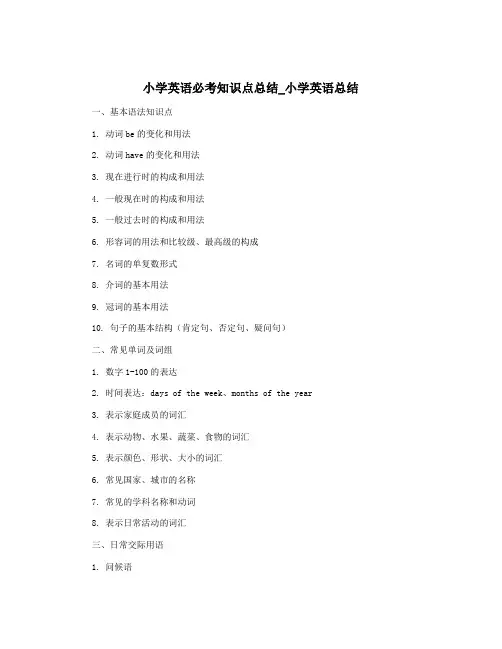
小学英语必考知识点总结_小学英语总结一、基本语法知识点1. 动词be的变化和用法2. 动词have的变化和用法3. 现在进行时的构成和用法4. 一般现在时的构成和用法5. 一般过去时的构成和用法6. 形容词的用法和比较级、最高级的构成7. 名词的单复数形式8. 介词的基本用法9. 冠词的基本用法10. 句子的基本结构(肯定句、否定句、疑问句)二、常见单词及词组1. 数字1-100的表达2. 时间表达:days of the week、months of the year3. 表示家庭成员的词汇4. 表示动物、水果、蔬菜、食物的词汇5. 表示颜色、形状、大小的词汇6. 常见国家、城市的名称7. 常见的学科名称和动词8. 表示日常活动的词汇三、日常交际用语1. 问候语2. 表示喜欢或不喜欢的词汇3. 表示身体部位的词汇4. 表示情感的词汇5. 表示方向的词汇四、常见句型1. What’s this/that? It’s a/an…2. Is this/that a …? Yes, it is. / No, it isn’t.3. What colour is it? It’s…4. How many… are there? There are…5. What’s your/his/her name? My/His/Her name is…6. How old are you? I am … years old.7. Do you like…? Yes, I do. / No, I don’t.8. Where are you from? I am from…五、日常活动1. 描述日常活动的词汇及句子2. 描述日常活动的频率:always、usually、often、sometimes、never3. 表达日常活动所需的动词短语六、常见情景对话1. 自我介绍2. 询问年龄、姓名3. 询问喜欢的食物、颜色等4. 询问材料、颜色5. 询问位置、方向七、常见教学用语1. 教室用语和课堂指令2. 学习用具的名称3. 学习场所和物品的名称八、其他1. 常用生活用语和短语2. 主题相关的歌曲、儿歌和故事3. 形式多样的综合练习题,包括听力、口语、阅读、写作。
(超详)小学英语知识点归纳汇总

(超详)小学英语知识点归纳汇总
1. 语法知识点
- 主谓一致:主语和谓语动词在人称和数上保持一致。
- 形容词和副词的比较级和最高级:用于比较两个或多个事物的形容词和副词的变化形式。
- 名词的单复数:名词变化形式表示单数或复数。
- 时态:表示动作发生的时间,包括现在时、过去时和将来时等。
2. 词汇知识点
- 常用的基础词汇:包括数字、颜色、家庭成员、动物、食物等基本词汇。
- 动词:常用的动词及其过去式和现在分词形式。
- 名词:常见的名词及其单数和复数形式。
- 形容词和副词:用于描述事物的形容词和表示方式的副词。
3. 句型知识点
- 祈使句:用于表达命令、请求或建议的句子。
- 选择疑问句:用于提问时给出的选择项。
- 陈述句:陈述一个事实或描述一个情况的句子。
- 疑问句:用于提出问题的句子。
4. 阅读知识点
- 词义猜测:通过上下文推测词语的意思。
- 主旨理解:理解文章的中心思想或要点。
- 细节理解:理解文章中的具体细节信息。
- 推理判断:根据已有信息推断出未提及的信息。
以上是小学英语的一些基本知识点归纳汇总,希望对您有帮助!。
人教精通版小学六年级英语下册期末考试知识总结
人教精通版小学六年级英语下册期末考试
知识总结
本文档对人教精通版小学六年级英语下册期末考试知识进行总结,旨在帮助学生复和备考。
1. 词汇与拼写
本节主要总结下册中重要的单词和拼写规则。
- 研究新单词的正确拼写。
- 复已学单词的拼写和词义。
2. 语法
本节主要总结下册中涉及的语法知识点。
- 时态:一般现在时、一般过去时和一般将来时。
- 句型结构:陈述句、疑问句和否定句。
- 代词:人称代词、物主代词、指示代词等。
- 数量词:用于表示数量的词语。
3. 阅读理解
本节主要总结下册中的阅读理解部分。
- 阅读短文,理解短文内容。
- 回答与短文相关的问题。
- 根据短文填写信息或选择正确的答案。
4. 口语与写作
本节主要总结下册中涉及的口语和写作知识。
- 口头表达能力:运用已学的句型和单词进行口头表达。
- 书面表达能力:根据题目要求写出一篇对话或短文。
5. 音标与发音
本节主要总结下册中的音标和常见的发音规则。
- 掌握音标的发音和书写。
- 根据单词的发音规则正确读音。
6. 其他技能
本节主要总结下册中的其他技能。
- 听力技巧:听懂对话和短文,回答相应问题。
- 句子翻译:将中文句子翻译成英文,或将英文句子翻译成中文。
希望以上总结能够帮助学生顺利备考并取得好成绩。
祝大家考试顺利!。
小学英语知识点最全整理
小学英语知识点最全整理小学英语知识点最全整理第一局部:根底知识1.字母:26个字母的大小写2.语音:元音的发音五个元音字母:AEIOU12个单元音:前元音:[i:] [ɪ] /e/ [æ]中元音:[ɜ:] [ə]后元音:[ɑ:] [ɒ] [ɔ:] [u :] [ʊ] [ʌ]双元音(8个)Ⅰ.合口双元音(5个)[ai] [ei] [au] [əu] [ɔi]Ⅱ.集中双元音(3个) [iə][εə][uə]3.词汇:词汇量,近反义词4.句子:大小写,标点符号第二局部:语法知识一.名词:名词单复数,名词的格(一)名词单复数1.一般情况,直接加-s,如:book-books, bag-bags, cat-cats, bed-beds2.以s. 某. sh. ch结尾,加-es,如:bus-buses, bo某-bo某es, brush-brushes, watch-watches3.以“辅音字母+y〞结尾,变y为i, 再加-es,如:family-families, strawberry-strawberries4.以“f或fe〞结尾,变f或fe为v, 再加-es,如:knife-knives5.不规那么名词复数:man-men, woman-women, policeman-policemen, policewoman-policewomen, mouse-micechild-children, foot-feet, tooth-teeth, fish-fish, people-people, Chinese-Chinese, Japanese-Japanese不可数名词的复数就是原型: paper, juice, water, milk, rice, tea(二)名词的格(1) 有生命的东西的名词所有格:a) 单数后加's 如: Lucy's ruler my father's shirtb) 以s 结尾的复数名词后加'如: his friends'bagsc) 不以s 结尾的复数后加's children's shoesl并列名词中,如果把's加在最后一个名词后,表示共有, 如:Tom and Mike's car 汤姆和迈克共有的小汽车l要表示所有物不是共有的,应分别在并列名词后加'sTom’s and Mike’s cars 汤姆和麦克各自的小汽车(2)表示无生命东西的名词通常用“ of +名词〞来表示所有关系:如:a picture of the classroom a map of China第三局部:语法知识二.冠词:不定冠词,定冠词种类:(1)不定冠词:a / an a unit / an uncle元音开头的可数名词前用an :an egg / an apple / an orange / an eraser / an answer / an ID card / an alarm clock / an actor / an actress / an e-mail / an address / an event / an e某ample / an opera / an houran old man / an interesting book / an e某citing sport / an action movie / an art lesson /(2)定冠词:the the egg the plane2. 用法:定冠词的用法:(1)特指某(些)人或某(些)物: The ruler is on the desk.(2)复述上文提到的人或物:He has a sweater. The sweater is new.(3)谈话双方都知道的人或物:The boys aren’t at school.(4)在序数词前:John’s birthday is February the second.(5)用于固定词组中: in the morning / afternoon / evening不用冠词的情况:(1)专有名词前:China is a big country.(2)名词前有定语:this , that , my , your , some, any , no 等:This is my baseball.(3)复数名词表示一类人和事:Monkeys can’t swim. They are teachers.(4)在节日,日期,月份,季节前:Today is Christmas Day. It’s Sunday.(5)一日三餐前:We have breakfast at 6:30.(6)球类棋类运动前:They often play football after class. He plays chess at home._ 但乐器前要用定冠词:I play the guitar very well.(7)学科名称前:My favorite subject is music.(8)在称呼或头衔的名词前:This is Mr Li.(9)固定词组中:at noon at night by bus第四局部:语法知识三、代词、形容词、副词代词:人称代词,物主代词人称代词物主代词主格宾格第一人称单数I(我)memy(我的)复数we(我们)usour(我们的)第二人称单数you(你)youyour(你的)复数you(你们)youyour(你们的)第三人称单数he(他)himhis(他的)she(她)herher(她的)it(它)itits(它的)复数they(他们/她们/它们)themtheir(他们的/她们的/它们的)形容词,副词:比拟级,最高级(一)、形容词的比拟级1、形容词比拟级在句子中的运用:两个事物或人的比拟用比拟级,比拟级后面一般带有单词than。
小学英语1-6年级要点知识点汇总(背熟期末考满分)
小学英语1-6年级要点知识点汇总(背熟期末考满分)第一部分:基础知识1.字母:26个字母的大小写ABCDEFGHIJKLMNOPQRSTUVWXYZabcdefghijklmnopqrstuvwxyz2.语音:元音的发音五个元音字母:AEIOU12个单元音:前元音:[i:] [ɪ] /e/ [æ]中元音:[ɜ:] [ə]后元音:[ɑ:] [ɒ] [ɔ:] [u :] [ʊ] [ʌ]双元音(8个)Ⅰ.合口双元音(5个)[ai] [ei] [au] [əu] [ɔi]Ⅱ.集中双元音(3个)[iə][εə][uə]3.词汇:词汇量,近反义词4.句子:大小写,标点符号第二部分:语法知识(1)一.名词:名词单复数,名词的格(一)名词单复数1.一般情况,直接加-s,如:book-books, bag-bags, cat-cats, bed-beds2.以s. x. sh. ch结尾,加-es,如:bus-buses, box-boxes, brush-brushes, watch-watches3.以“辅音字母+y”结尾,变y为i, 再加-es,如:family-families, strawberry-strawberries4.以“f或fe”结尾,变f或fe为v, 再加-es,如:knife-knives5.不规则名词复数:man-men, woman-women, policeman-policemen, policewoman-policewomen, mouse-mice child-children, foot-feet, tooth-teeth, fish-fish, people-people, Chinese-Chinese, Japanese-Japanese不可数名词的复数就是原型:paper, juice, water, milk, rice, tea(二)名词的格(1) 有生命的东西的名词所有格:a) 单数后加’s 如: Lucy’s ruler my father’s shirtb) 以s 结尾的复数名词后加’如: his friends’bagsc) 不以s 结尾的复数后加’s children’s shoesl并列名词中,如果把’s加在最后一个名词后,表示共有, 如:Tom and Mike’s car 汤姆和迈克共有的小汽车l要表示所有物不是共有的,应分别在并列名词后加’sTom’s and Mike’s cars 汤姆和麦克各自的小汽车(2)表示无生命东西的名词通常用“of +名词”来表示所有关系:如:a picture of the classroom a map of China第二部分:语法知识(2)二.冠词:不定冠词,定冠词种类:(1)不定冠词:a / an a unit / an uncle元音开头的可数名词前用an :an egg / an apple / an orange / an eraser / an answer / an ID card / an alarm clock / an actor / an actress / an e-mail / an address / an event / an example / an opera / an houran old man / an interesting book / an exciting sport / an action movie / an art lesson /(2)定冠词:the the egg the plane2. 用法:定冠词的用法:(1)特指某(些)人或某(些)物:The ruler is on the desk.(2)复述上文提到的人或物:He has a sweater. The sweater is new.(3)谈话双方都知道的人或物:The boys aren’t at school.(4)在序数词前:John’s birthday is February the second.(5)用于固定词组中:in the morning / afternoon / evening不用冠词的情况:(1)专有名词前:China is a big country.(2)名词前有定语:this , that , my , your , some, any , no 等:This is my baseball.(3)复数名词表示一类人和事:Monkeys can’t swim. They are teachers.(4)在节日,日期,月份,季节前:Today is Christmas Day. It’s Sunday.(5)一日三餐前:We have breakfast at 6:30.(6)球类棋类运动前:They often play football after class. He plays chess at home.* 但乐器前要用定冠词:I play the guitar very well.(7)学科名称前:My favorite subject is music.(8)在称呼或头衔的名词前:This is Mr Li.(9)固定词组中:at noon at night by bus第二部分:语法知识(3)三、代词、形容词、副词代词:人称代词,物主代词人称代词物主代词主格宾格第一人称单数I(我)memy(我的)复数we(我们)usour(我们的)第二人称单数you(你)youyour(你的)复数you(你们)youyour(你们的)第三人称单数he(他)himhis(他的)she(她)herher(她的)it(它)itits(它的)复数they(他们/她们/它们)themtheir(他们的/她们的/它们的)形容词,副词:比较级,最高级(一)、形容词的比较级1、形容词比较级在句子中的运用:两个事物或人的比较用比较级,比较级后面一般带有单词than。
英语小学考题知识点汇总
英语小学考题知识点汇总英语是小学生学习的重要科目之一,考试是检验他们学习成果的重要方式。
为了帮助同学们复习和总结英语学习的知识点,下面将对英语小学考题中常见的知识点进行汇总和总结。
一、单词拼写与词汇应用1. 基础词汇:例如人称代词I、you、he、she、it,动词be的各种形式如am、is、are,常见动词如play、eat、drink、like,以及常见的名词、形容词等。
2. 数字词汇:例如基础的数字1-10、20-100等。
3. 季节与月份:例如四季对应的词汇,以及月份的英文表达。
4. 时间与星期:例如一天的各个时间段,以及星期一至星期日的英文表达。
5. 常见动词短语:例如go to school、have breakfast、watch TV等。
二、基础的语法知识1. 句子成分:例如主语、谓语、宾语的识别与理解。
2. 时态:例如一般现在时、一般过去时、一般将来时的用法及其标志词。
3. 介词:例如in、on、at等常见介词的用法。
4. 名词复数形式:例如一般情况下,名词变为复数的形式规则,如加s或es等。
5. 代词:代词的分类及其在句子中的使用,如主格、宾格、物主代词等。
三、日常生活对话与交际用语1. 问候语与礼貌用语:例如hello、hi、thank you、you're welcome 等。
2. 日常生活用语:例如表达饮食、购物、问路、询问时间等方面的常用表达。
3. 日常交际对话:例如简单的自我介绍、问候对话、求助或提供帮助的场景等。
四、阅读理解1. 根据图片选择正确答案:根据给定图片选择正确的单词或短语。
2. 根据问题选择正确答案:根据给定问题选择正确的答案或回答问题。
3. 根据短文回答问题:阅读给定的短文,根据短文内容回答相关问题。
五、听力训练1. 听音选图:根据听到的单词或句子选择正确的图片。
2. 听问句选择答句:根据听到的问句选择正确的答句。
3. 听短文回答问题:听一段短文,根据短文内容回答相关问题。
- 1、下载文档前请自行甄别文档内容的完整性,平台不提供额外的编辑、内容补充、找答案等附加服务。
- 2、"仅部分预览"的文档,不可在线预览部分如存在完整性等问题,可反馈申请退款(可完整预览的文档不适用该条件!)。
- 3、如文档侵犯您的权益,请联系客服反馈,我们会尽快为您处理(人工客服工作时间:9:00-18:30)。
小学英语期末考试知识点大全一、基础知识1.字母:26个字母的大小写A B C D E F G H I J K L M N O P Q R S T U V W X Y Za b c d e f g h i j k l m n o p q r s t u v w x y z2.语音:元音的发音5个元音字母:A E I O U12个单元音:前元音:[i:] [ɪ] [e] [æ]中元音:[ɜ:] [ə]后元音:[ɑ:] [ɒ] [ɔ:] [u:] [ʊ] [ʌ]双元音(8个)合口双元音[ai] [ei] [au] [əu] [ɔi]集中双元音[iə] [εə] [uə]3.词汇:词汇量,近反义词4.句子:大小写,标点符号二、语法知识名词:名词单复数,名词的格(一)名词单复数一般情况,直接加-s,如:book-books, bag-bags, cat-cats, bed-beds以s. x. sh. ch结尾,加-es,如:bus-buses, box-boxes, brush-brushes, watch-watches以“辅音字母+y”结尾,变y 为i, 再加-es,如:family-families, strawberry-strawberries 以“f 或fe”结尾,变f 或fe 为v, 再加-es,如:knife-knives不规则名词复数:man-men,woman-women,policeman-policemen,policewoman-policewomen,mouse-micechild-children,foot-feet,tooth-teeth,fish-fish,people-people,Chinese-Chinese,Japanese-Japanese不可数名词的复数就是原形:paper,juice, water, milk, rice, tea(二)名词的格(1) 有生命的东西的名词所有格:a) 单数后加\\\\\\'s 如: Lucy\\\\\\'s ruler, my father\\\\\\'s shirtb) 以s 结尾的复数名词后加’如: his friends\\\\\\' bagsc) 不以s 结尾的复数后加\\\\\\'s children\\\\\\'s shoes并列名词中,如果把\\\\\\'s加在最后一个名词后,表示共有, 如: Tom and Mike\\\\\\'s car 汤姆和迈克共有的小汽车要表示所有物不是共有的,应分别在并列名词后加\\\\\\'s, 如:Tom\\\\\\'s and Mike\\\\\\'s cars 汤姆和麦克各自的小汽车(2) 表示无生命东西的名词通常用“of +名词”来表示所有关系:如: a picture of the classroom a map of China冠词:不定冠词,定冠词种类(1) 不定冠词:a / an a unit / an uncle元音开头的可数名词前用an :an egg / an apple / an orange(2) 定冠词:thethe egg / the plane2. 用法:定冠词的用法:特指某(些)人或某(些)物:The ruler is on the desk.复述上文提到的人或物:He has a sweater. The sweater is new.谈话双方都知道的人或物:The boys aren\\\\\\'t at school.在序数词前:John\\\\\\'s birthday is February the second.用于固定词组中:in the morning / afternoon / evening不用冠词的情况:专有名词前:China is a big country.名词前有定语:this , that , my , your , some, any , no 等:This is my baseball.复数名词表示一类人和事:Monkeys can\\\\\\'t swim. They are teachers.在节日,日期,月份,季节前:Today is Christmas Day. It\\\\\\'s Sunday.一日三餐前:We have breakfast at 6:30.球类棋类运动前:They often play football after class. He plays chess at home.* 但乐器前要用定冠词:I play the guitar very well.学科名称前:My favorite subject is music.在称呼或头衔的名词前:This is Mr Li.固定词组中:at noon at night by bus代词、形容词、副词代词:人称代词,物主代词形容词,副词:比较级,最高级(一)、形容词的比较级1. 形容词比较级在句子中的运用:两个事物或人的比较用比较级,比较级后面一般带有单词than。
比较级前面可以用more, a little 来修饰表示程度。
than后的人称代词用主格(口语中可用宾格)。
2. 形容词加er的规则:一般在词尾加er ;以字母e 结尾,加r ;以一个元音字母和一个辅音字母结尾,应双写末尾的辅音字母,再加er ;以“辅音字母+y”结尾,先把y变i,再加er 。
3. 不规则形容词比较级:good-better,beautiful-more beautiful(二)副词的比较级1. 形容词与副词的区别(有be用形,有形用be;有动用副,有副用动)⑴在句子中形容词一般处于名词之前或be动词之后⑵副词在句子中最常见的是处于实义动词之后2. 副词比较级的变化规则基本与形容词比较级相同(不规则变化:well-better, far-farther)数词:序数词、基数词(1) 1-20one,two,three, our, five, six, seven, eight, nine, ten, eleven, twelve, thirteen, fourt een, fifteen, sixteen, seventeen, eighteen, nineteen, twenty(2) 21-99 先说“几十”,再说“几”,中间加连字符。
23→twenty-three,34→thirty-four,45→forty—five,56→fifty-six,67→sixty-seven,78→seventy-eight,89→eighty-nine,91→ninety-one(3) 101—999先说“几百”,再加and,再加末两位数或末位数;586→five hundred and eighty-six,803→eight hundred and three(4) 1,000以上,先从右往左数,每三位数加一个“,”,第一个“,”前为thousand. 第二个“,”前为million,第三个“,”前为billion1,001→one thousand and one18,423→eighteen thousand four hundred and twenty-three6,260,309→six million two hundred and sixty thousand three hundred and nine750,000,000,000→seven hundred and fifty bilion序数词(1) 一般在基数词后加theg. four→fourth, thirteen→thirteenth(2) 不规则变化one→first,two→second,three→third,five→fifth,eight→eighth,nine→ninth,twelve—twelfth(3) 以y 结尾的十位整数,变y 为ie 再加thtwenty→twentieth,forty→fortieth,ninety→ninetieth(4) 从二十一后的“几十几”直至“几百几十几”或“几千几百几十几”只将个位的基数词变为序数词。
twenty-first,two hundred and forty-fifth基数词基数词转为序数词的口诀:基变序,有规律,词尾加上-th.一,二,三,特殊记,词尾字母t, d, d.八去t, 九去e, ve要用f替。
ty 将y变成i,th 前面有个e.若是碰到几十几,前用基来后用序。
介词:常用介词:in, on, at, behind等1. at 表示时间概念的某一个点。
(在某时刻、时间、阶段等)。
at 1:00 (dawn,midnight , noon) 在一点钟(黎明、午夜、中午)2.on1) 表示具体日期。
注:(1)关于"在周末"的几种表示法:at (on) the weekend在周末---特指at (on) weekends在周末---泛指over the weekend在整个周末during the weekend在周末期间(2)在圣诞节,应说at Christmas? 而不说on Christmas?2) 在(刚……)的时候On reaching the city he called up his parents.一到城里他就给父母打了一个电话。
3.in1) 表示"时段"、"时期",在多数情况下可以和during 互换,前者强调对比,后者强调持续。
in (during) 1988 (December, the 20th century) 在一九八八年(十二月、二十世纪)动词:动词的四种时态(1) 一般现在时:一般现在时的构成1. be动词:主语+be (am, is, are)+其它。
如:I am a boy. 我是一个男孩。
2. 行为动词:主语+行为动词(+其它)。
如:We study English. 我们学习英语。
当主语为第三人称单数(he, she, it)时,要在动词后加"-s"或"-es"。
如:Mary likes Chinese. 玛丽喜欢汉语。
动词+s的变化规则1.一般情况下,直接加-s,如:cook-cooks, milk-milks2.以s. x. sh. ch. o 结尾,加-es,如:guess-guesses, wash-washes, watch-watches, go-goes3.以“辅音字母+y 结尾,变y为i, 再加-es,如:study-studies(2) 一般过去时:动词过去式详解动词的过去式的构成规则有:A、规则动词①一般直接在动词的后面加ed:如worked , learned , cleaned , visited②以e结尾的动词直接加d:如lived , danced , used③以辅音字母加y结尾的动词要改y 为i 再加ed (此类动词较少)如study –studied carry –carried worry –worried (注意play、stay不是辅音字母加y ,所以不属于此类)④双写最后一个字母(此类动词较少)如stoppedB、不规则动词(此类词并无规则,须熟记)小学阶段要记住以下动词的原形和过去式:sing –sang , eat –ate ,see –saw , have –had , do –did , go –went , take –took , buy –bought , get –got , read –read ,fly –flew , am/is –was ,are –were , say –said , leave –left , swim –swam , tell –told , draw –drew , come –came , lose –lost , find –found , drink –drank , hurt –hurt , feel –felt(3) 一般将来时:基本结构:①be going to + do;②will+ do. be going to = willI am going to go swimming tomorrow(明天). = I will go swimming tomorrow.(4) 现在进行时: am,is,are+动词现在分词动词现在分词详解动词的ing形式的构成规则:①一般的直接在后面加上ing , 如doing , going , working , singing , eating②以e 结尾的动词,要先去e再加ing,如having , writing③双写最后一个字母的(此类动词极少)有:running , swimming , sitting , getting三、句法1.陈述句(1) 肯定句:是指用肯定的语气来陈述的句子,如:I\\\\\\'m a student. She is a doctor. He works in a hospital.There are four fans in our classroom. He will eat lunch at 12:00. I watched TV yesterday eveni ng.(2) 否定句:含有否定词或表示否定意义词的句子,如:I\\\\\\'m not a student. She is not (isn\\\\\\'t) a doctor.He does not (doesn\\\\\\'t) work in a hospital. There are not (aren\\\\\\'t) four fans in our clas sroom.He will not (won\\\\\\'t) eat lunch at 12:00. I did not (didn\\\\\\'t) watch TV yesterday evening.2. 疑问句一般疑问句:是指询问事实的句子,此类句子必须用“yes",或“no”来回答。
